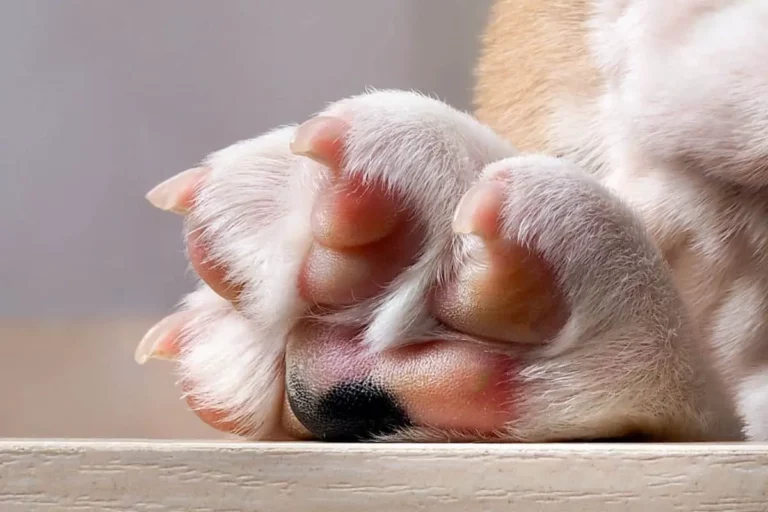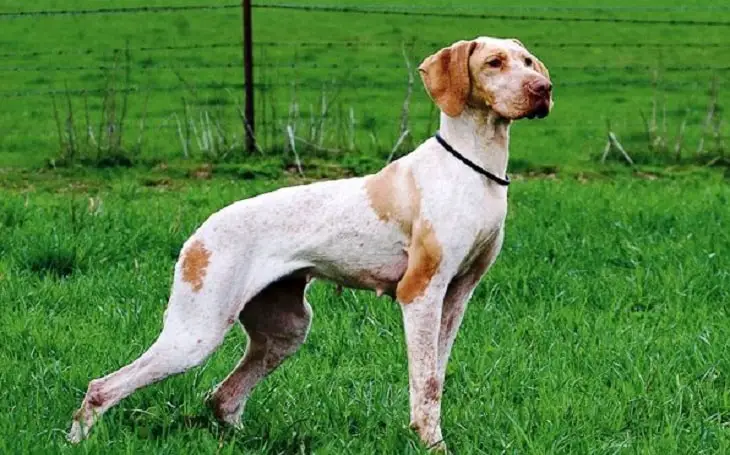How to Get Rid of Black Gums on Dogs: A Comprehensive Guide
Maintaining your dog’s oral health is vital, as neglect can lead to serious health issues, including gum disease and heart and kidney problems. Black gums in dogs might be natural or indicate health concerns.
This guide will explain the reasons behind black gums and provide advice on prevention and treatment, helping you keep your dog’s oral health in check.
Key takeaways
Black gums in dogs can be natural due to pigmentation, or a sign of health issues like dental diseases or infections.
Breeds like Chows and Shar-Peis naturally have black gums due to their genetics.
Unusual black spots or a sudden change in gum color could indicate a medical issue and warrant a vet visit.
Regular dental check-ups, brushing your dog’s teeth, and providing dental treats can help maintain your dog’s oral health.
Severe cases of dental diseases causing black gums may require professional dental cleanings or surgeries.
Always consult a vet if you notice any changes in your dog’s gum color to ensure proper treatment.
Understanding Black Gums in Dogs
Natural pigmentation and breeds prone to black gums
Before jumping to conclusions about black gums in your dog, it’s crucial to understand that some breeds have naturally darker pigmentation on their gums.
This pigmentation is harmless and genetic, which means it’s a normal characteristic for the specific breed. Dog breeds such as Chow Chows, Labradors, Pugs, and German Shepherds are more prone to having naturally black or dark-colored gums.
Causes of unnatural black gums
On the other hand, if your dog doesn’t belong to a breed prone to black gums or if there is a sudden change in gum color, there could be underlying health issues that need to be addressed. Some common causes of unnatural black gums in dogs include:
- Dental diseases: Periodontal disease, gingivitis, and other dental problems can cause discoloration of your dog’s gums. These issues are usually accompanied by bad breath, bleeding, and swollen gums.
- Infections: Bacterial or fungal infections in your dog’s mouth can lead to inflammation and black gums. If left untreated, these infections can spread and cause more severe health issues.
- Trauma: Injuries to your dog’s mouth, such as a bite or a foreign object lodged in the gum, can cause the gums to turn black. These cases often require immediate veterinary attention.
- Tumors: Oral tumors and melanoma can also cause black discoloration on your dog’s gums. While some tumors are benign, others can be malignant and require aggressive treatment.
Distinguishing between normal and abnormal black gums
To determine if your dog’s black gums are a cause for concern or simply natural pigmentation, pay attention to the overall appearance and texture of the gums. Healthy gums should be smooth, moist, and free of swelling or inflammation. If you notice any changes in your dog’s gum color, shape, or texture, it’s best to consult your veterinarian for an accurate diagnosis and appropriate treatment.

How to Check Your Dog’s Gums
Identifying healthy gum color
A healthy gum color can vary depending on your dog’s breed and individual characteristics. Generally, healthy gums should be pink, but they can also have black or brown pigmentation, especially in certain breeds. It’s essential to familiarize yourself with your dog’s normal gum color and texture, so you can quickly identify any potential issues.
Step-by-step process of checking gums
Regularly checking your dog’s gums will help you monitor their oral health and catch any problems early on. Here’s a step-by-step guide on how to examine your dog’s gums:
- Choose a calm and quiet environment to avoid distractions.
- Gently hold your dog’s muzzle, and if necessary, use treats or praise to make the experience positive.
- Carefully lift your dog’s upper lip to expose the gums.
- Observe the color, texture, and moisture of the gums.
- Gently press on the gums with your fingertip and release; the gums should momentarily turn white and quickly return to their normal color, indicating proper blood circulation.
When to consult a veterinarian
If you notice any of the following signs while checking your dog’s gums, it’s essential to consult your veterinarian as soon as possible:
- Sudden changes in gum color or texture
- Swollen or bleeding gums
- Persistent bad breath
- Visible growths or lumps
- Signs of pain or discomfort when touching the gums
Remember that early detection and intervention can make a significant difference in your dog’s oral health and overall well-being.
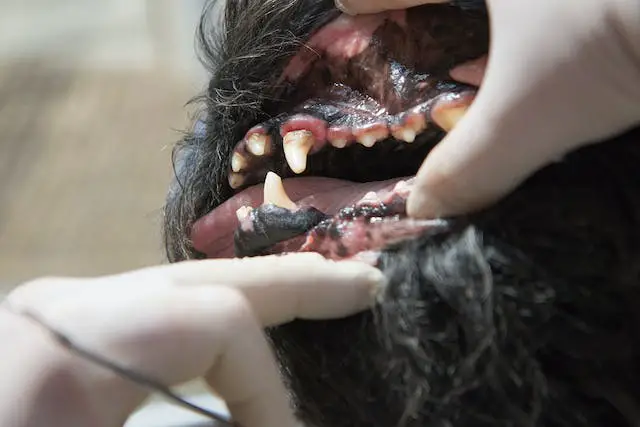
Preventing and Treating Black Gums in Dogs
Regular dental care
One of the most effective ways to prevent and treat black gums in dogs is by establishing a consistent dental care routine. Good oral hygiene helps to eliminate bacteria and plaque build-up, which can cause gum disease and discoloration. Here are some dental care practices you can incorporate into your dog’s routine:
- Brushing your dog’s teeth: Use a dog-specific toothpaste and a soft-bristle toothbrush to gently clean your dog’s teeth daily or at least several times a week. Make sure to reach all surfaces of the teeth, including the gumline, to remove plaque effectively.
- Dental chews and toys: Provide your dog with dental chews and toys that are designed to help clean their teeth and gums as they chew. These items can help reduce plaque buildup and keep your dog’s mouth fresh between brushings.
- Professional cleanings: Schedule regular professional dental cleanings with your veterinarian to remove plaque and tartar that can contribute to gum disease and discoloration.
Monitoring and managing oral health
In addition to a consistent dental care routine, it’s essential to monitor your dog’s oral health and address any potential issues as they arise:
- Regular oral examinations: Perform monthly gum checks to detect any changes in gum color, texture, or overall oral health.
- Monitoring for signs of dental problems: Keep an eye on your dog’s behavior and watch for signs of dental issues, such as pawing at the mouth, difficulty eating, or excessive drooling.
Treatment options for black gums
If your dog’s black gums are a result of an underlying health issue, your veterinarian may recommend one or more of the following treatment options:
- Antibiotics: In the case of bacterial infections, your veterinarian may prescribe antibiotics to treat the infection and help restore your dog’s gum health.
- Dental cleaning and scaling: If your dog’s black gums are due to plaque and tartar build-up, a professional dental cleaning can help remove the build-up and improve gum health.
- Surgical intervention: In some cases, such as oral tumors or severe dental diseases, your veterinarian may recommend surgery to remove the affected tissue and restore your dog’s oral health.
Remember that early intervention and consistent dental care are crucial in preventing and treating black gums in dogs. By maintaining a proactive approach to your dog’s oral health, you can help ensure they have a healthy and happy life.
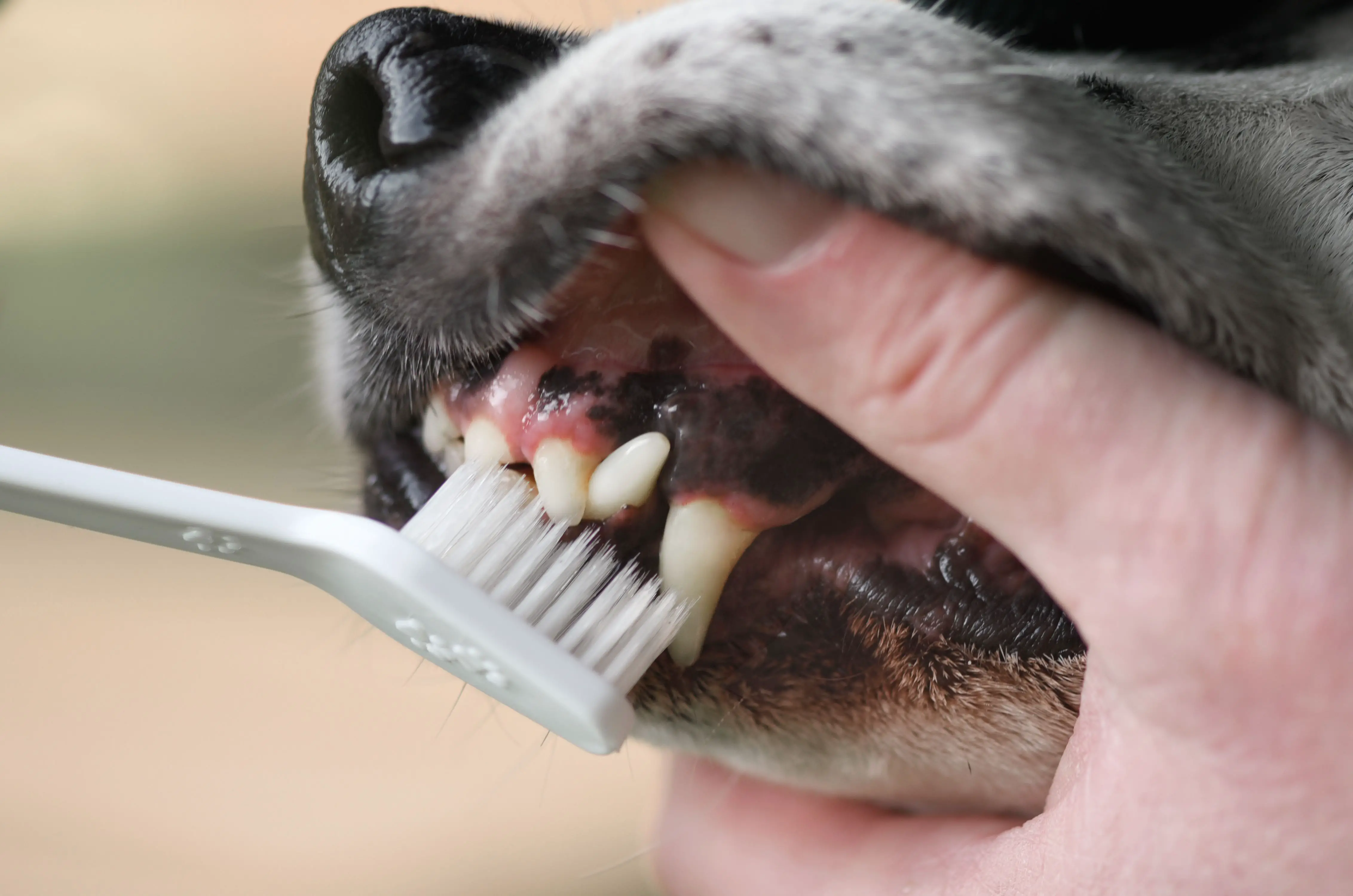
Additional Tips for Maintaining Your Dog’s Oral Health
Providing a well-balanced diet
Feeding your dog a well-balanced diet can help maintain their overall health, including their oral health. Consider these dietary tips to support your dog’s dental health:
- High-quality dog food: Choose a dog food that meets your pet’s nutritional needs and is appropriate for their age, size, and activity level. High-quality dog food can help prevent dental issues and contribute to overall health.
- Avoiding sugary treats: Sugary treats can contribute to plaque buildup and dental problems. Opt for healthier, dental-friendly treats to reward your dog.
- Including dental-friendly snacks: Incorporate snacks that promote dental health, such as crunchy vegetables or dental chews, to help clean your dog’s teeth naturally.
Choosing the right dental care products
Selecting the right dental care products can make a significant difference in maintaining your dog’s oral health:
- Dog toothpaste and toothbrush options: Look for pet-specific toothpaste and toothbrushes that are designed for dogs’ unique oral needs. Avoid using human toothpaste, as it can be harmful to your pet.
- Water additives for dental health: Consider adding dental water additives to your dog’s drinking water to help reduce plaque and freshen their breath.
- Dental wipes for on-the-go cleaning: Keep dental wipes on hand for quick and convenient cleaning sessions when brushing may not be possible.
Recognizing early warning signs of dental problems
Stay vigilant for early signs of dental issues that may indicate the need for intervention:
- Bad breath: Persistent bad breath may be a sign of dental problems, such as periodontal disease or infection.
- Difficulty eating: If your dog shows signs of discomfort or pain while eating, it could be an indication of dental issues.
- Pawing at the mouth: Your dog may paw at their mouth if they’re experiencing pain or discomfort related to oral health problems.
By incorporating these additional tips into your dog’s oral care routine, you can further support their dental health and prevent issues like black gums from arising. Remember that a proactive approach to dental care and a strong partnership with your veterinarian are essential to maintaining your dog’s overall health and well-being.
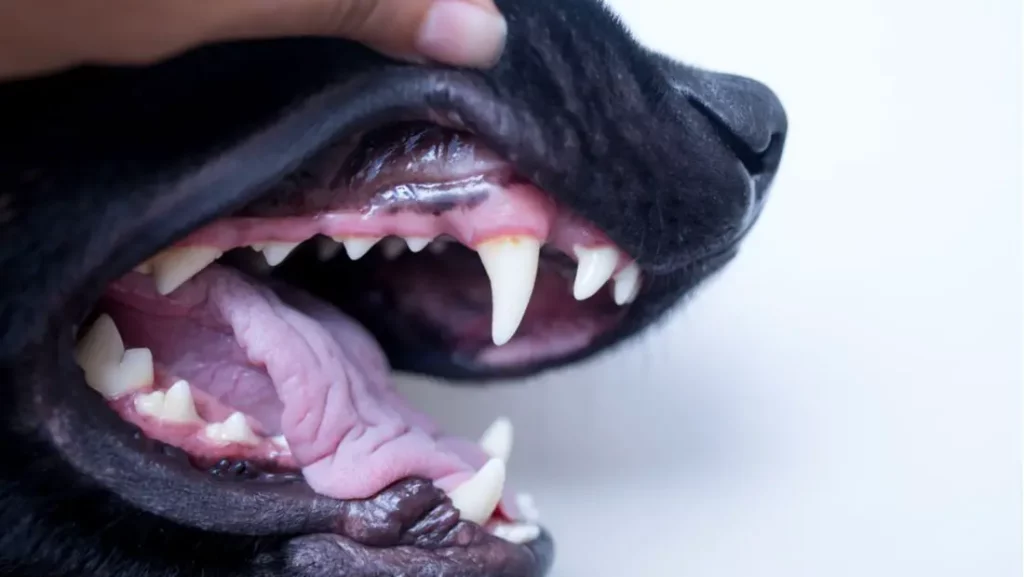
Building a Supportive Relationship with Your Veterinarian
Importance of regular veterinary visits
Regular veterinary check-ups are essential to monitor your dog’s overall health, including their oral health. Your veterinarian can detect early signs of dental issues and provide guidance on preventive care, ensuring your dog’s gums and teeth remain in good condition.
Collaborating with your vet for preventive care
Working closely with your veterinarian helps you create a personalized preventive care plan tailored to your dog’s specific needs. Your vet can recommend appropriate dental care products, frequency of teeth cleanings, and provide dietary suggestions to promote your dog’s oral health.
Seeking professional advice for dental concerns
If you have concerns about your dog’s oral health, don’t hesitate to consult your veterinarian. They can accurately diagnose and recommend appropriate treatments for various dental issues, including black gums. A strong partnership with your vet will ensure you have the support and guidance needed to maintain your dog’s health.
In summary, a supportive relationship with your veterinarian is vital for managing your dog’s oral health and addressing any issues that may arise. Regular check-ups, personalized preventive care, and professional advice will help you maintain your dog’s overall health, including preventing and treating black gums.
Frequently Asked Questions
How often should I check my dog’s gums?
It’s recommended to check your dog’s gums at least once a month, or more frequently if your dog has a history of dental issues. By regularly examining your dog’s gums, you can monitor their oral health and catch potential problems early on.
Are some dog breeds more prone to black gums?
Yes, certain breeds such as Chow Chows, Labradors, and Pugs have naturally darker pigmentation in their gums. However, it’s essential to familiarize yourself with your dog’s normal gum color, so you can quickly identify any changes that may indicate a health issue.
How can I make my dog more comfortable during a gum examination?
Start by making it a positive experience with praise, gentle handling, and offering treats. Over time, your dog will become more comfortable with the process. Ensure that you perform the examination in a calm and quiet environment to minimize distractions and help your dog feel at ease.
When should I be concerned about my dog’s black gums?
Consult your veterinarian if you notice sudden changes in gum color, swelling, bleeding, or if your dog shows signs of pain or discomfort while eating. Early detection and intervention can significantly improve your dog’s oral health and overall well-being.
By addressing these frequently asked questions, dog owners can gain a better understanding of black gums in dogs and the steps they can take to maintain their pet’s oral health. Regular check-ups, consistent dental care, and working closely with a veterinarian are crucial factors in preventing and treating black gums in dogs.
Additional Resources and Support
For further information and support on maintaining your dog’s oral health and addressing concerns such as black gums, consider exploring the following resources:
Veterinary dental specialists
In addition to your regular veterinarian, you may also consider consulting a board-certified veterinary dentist. These specialists can provide advanced dental care and treatments for more complex oral health issues.
Online communities and forums
Joining online communities and forums dedicated to dog health and dental care can be an invaluable source of information, advice, and support from fellow dog owners. Sharing experiences and learning from others can provide you with insights and practical tips to help maintain your dog’s oral health.
You’ll find a list of the top online pet forums here: Online Dog Communities You Should Join | Cotswold RAW
Pet dental care organizations
Many organizations are dedicated to promoting pet dental care and providing resources for pet owners. Examples include the American Veterinary Dental College (AVDC) and the American Veterinary Medical Association (AVMA). These organizations offer educational materials, guidelines, and recommendations to help you take the best possible care of your dog’s oral health.
By exploring these additional resources and support options, you can continue expanding your knowledge and expertise in dog dental care. With a strong foundation in oral health maintenance and access to expert advice, you can confidently care for your dog’s gums and teeth, preventing and addressing black gums as needed.
Final Thoughts
As a responsible pet owner, it’s essential to prioritize your dog’s oral health and understand the importance of addressing any concerns, such as black gums. By educating yourself on the potential causes of black gums, establishing a regular dental care routine, and fostering a strong partnership with your veterinarian, you can ensure your dog’s gums and teeth remain healthy.
Remember that prevention is always better than treatment. Early detection of dental issues can significantly improve your dog’s overall well-being and quality of life. By following the recommendations and tips provided in this comprehensive guide, you can play an active role in keeping your dog’s oral health in top condition and enjoy many happy years with your furry companion.




